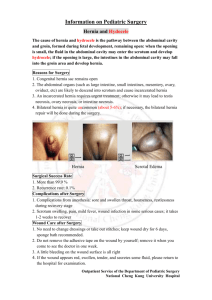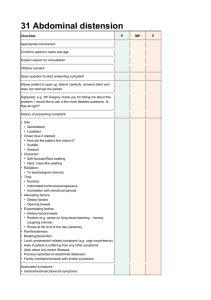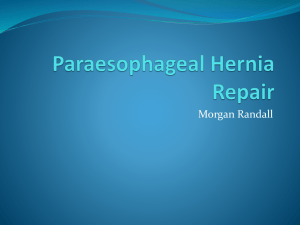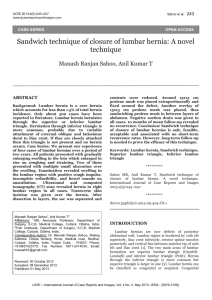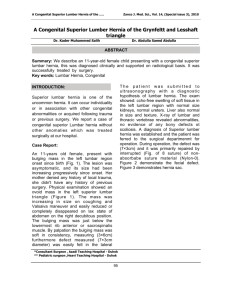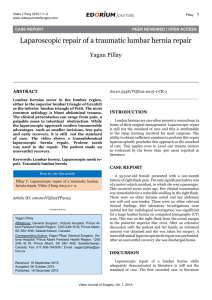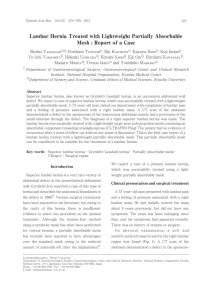Bilateral Petit's Triangle Hernia
advertisement
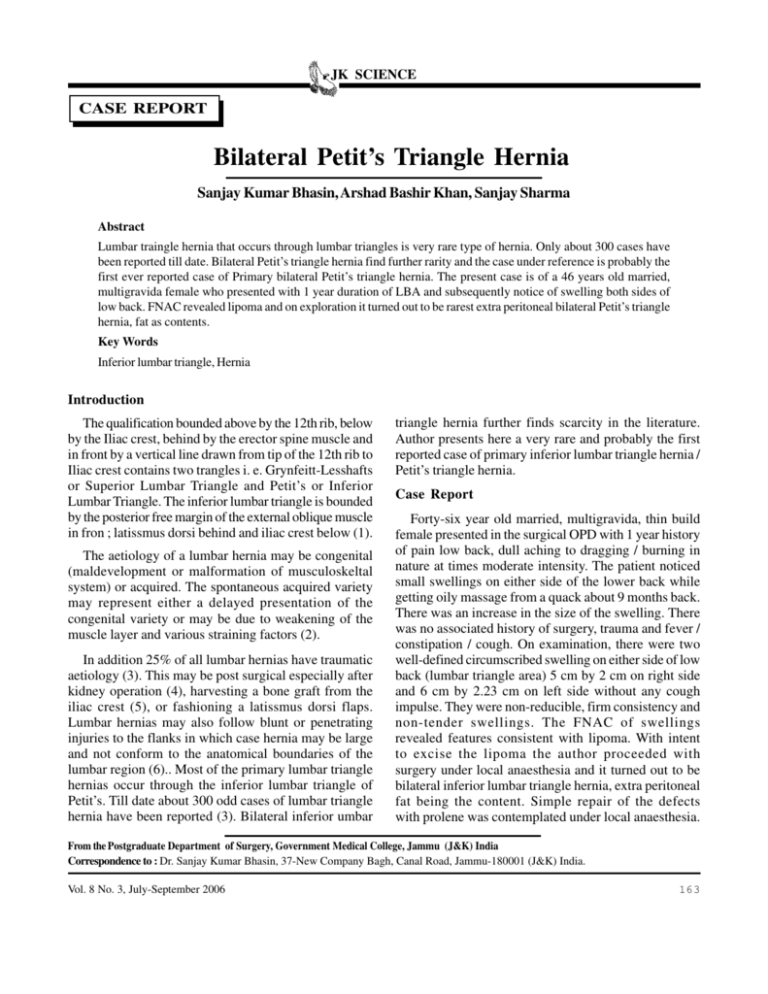
JK SCIENCE CASE REPORT Bilateral Petit’s Triangle Hernia Sanjay Kumar Bhasin, Arshad Bashir Khan, Sanjay Sharma Abstract Lumbar traingle hernia that occurs through lumbar triangles is very rare type of hernia. Only about 300 cases have been reported till date. Bilateral Petit’s triangle hernia find further rarity and the case under reference is probably the first ever reported case of Primary bilateral Petit’s triangle hernia. The present case is of a 46 years old married, multigravida female who presented with 1 year duration of LBA and subsequently notice of swelling both sides of low back. FNAC revealed lipoma and on exploration it turned out to be rarest extra peritoneal bilateral Petit’s triangle hernia, fat as contents. Key Words Inferior lumbar triangle, Hernia Introduction The qualification bounded above by the 12th rib, below by the Iliac crest, behind by the erector spine muscle and in front by a vertical line drawn from tip of the 12th rib to Iliac crest contains two trangles i. e. Grynfeitt-Lesshafts or Superior Lumbar Triangle and Petit’s or Inferior Lumbar Triangle. The inferior lumbar triangle is bounded by the posterior free margin of the external oblique muscle in fron ; latissmus dorsi behind and iliac crest below (1). The aetiology of a lumbar hernia may be congenital (maldevelopment or malformation of musculoskeltal system) or acquired. The spontaneous acquired variety may represent either a delayed presentation of the congenital variety or may be due to weakening of the muscle layer and various straining factors (2). In addition 25% of all lumbar hernias have traumatic aetiology (3). This may be post surgical especially after kidney operation (4), harvesting a bone graft from the iliac crest (5), or fashioning a latissmus dorsi flaps. Lumbar hernias may also follow blunt or penetrating injuries to the flanks in which case hernia may be large and not conform to the anatomical boundaries of the lumbar region (6).. Most of the primary lumbar triangle hernias occur through the inferior lumbar triangle of Petit’s. Till date about 300 odd cases of lumbar triangle hernia have been reported (3). Bilateral inferior umbar triangle hernia further finds scarcity in the literature. Author presents here a very rare and probably the first reported case of primary inferior lumbar triangle hernia / Petit’s triangle hernia. Case Report Forty-six year old married, multigravida, thin build female presented in the surgical OPD with 1 year history of pain low back, dull aching to dragging / burning in nature at times moderate intensity. The patient noticed small swellings on either side of the lower back while getting oily massage from a quack about 9 months back. There was an increase in the size of the swelling. There was no associated history of surgery, trauma and fever / constipation / cough. On examination, there were two well-defined circumscribed swelling on either side of low back (lumbar triangle area) 5 cm by 2 cm on right side and 6 cm by 2.23 cm on left side without any cough impulse. They were non-reducible, firm consistency and non-tender swellings. The FNAC of swellings revealed features consistent with lipoma. With intent to excise the lipoma the author proceeded with surgery under local anaesthesia and it turned out to be bilateral inferior lumbar triangle hernia, extra peritoneal fat being the content. Simple repair of the defects with prolene was contemplated under local anaesthesia. From the Postgraduate Department of Surgery, Government Medical College, Jammu (J&K) India Correspondence to : Dr. Sanjay Kumar Bhasin, 37-New Company Bagh, Canal Road, Jammu-180001 (J&K) India. Vol. 8 No. 3, July-September 2006 163 JK SCIENCE Fig. 1. Artery forceps indicating hernia defect in Petit’s Triangle so may investigation like barioum studh, IVU etc. have been recommended with an intent to find out which part of the bowl makes contents of the hernia but lately CT scan has been considered as one investigation that distinguishes muscular and fascial layers. In addition it differentiates between hematoma /abscess / soft tissue tumors (9-10). Ultrasound has also been proved useful in imaging a lumbar hernia (11). A lumbar hernia should be repaired sugically as it is prone to both obstruction and strangulation (12). Laparoscopic transabdominal preperitoneal mesh repair for lumbar hernia confers all the benefits of minimal access surgery to the patient and follows current principles of tensionless repair of ventral abdominal hernia (13). We repaired the defect with prolene on both side. Patient remained in follow up clinic for about one year. Patient was symptoms free and without any evidence of recurrence. Conclusion Congenital, spontaneoous as well as posttraumatic herniation through lumbar traingles is a very rare entity which can be confused with various conditions hence diagnosis requiring an appropriate index of suspicion and timely surgical treatment is highly warranted. References Fig. 2. Contralateral hernia dealt and skin sutures in progress Discussion Only about 300 cases of lumbar triangle hernia have been reported till date that shows the rarity of the condition (3,7,8). There is a possibility that because of asymptomatic or vague complains such as low backache (9), the diagnosis may further be missed or delayed in fatty patients or in post surgical patients in whom the classical presentation of a reducible flanks swelling, which gives an expansile impulse on coughing is uncommon. In such a situation, a long standig hernia is apt to be mistaken for lipoma, fibroma, a retroperitoneal tumor or a chronic abscess (1). Our case presented with history of low backache ranging from dull aching to moderate intensity, dragging / burning sensation with two palpable swellings on either side of spine in the lower back. We proceeded with provisional diagnosis of lipoma as preoperative FNAC also revealed the same. Although 164 1. Sarela AL, Mavanur AA, Bhaskar A et al. Post traumatic lumbar hernia. J Postgrad Med 1996 ; 42 : 78-80. 2. Ponka JL. Lumbar hernia. In : Ponka JL. Hernia of the abdominal wall. Philadelphia : Saunders 1980 pp 465-77. 3. Swartz WT. Lumbar hernia. In : Nyhus LM, Condon RE, (editors). Hernia, 2nd ed. Philadelphia : Lippincott 1978 pp 409-26. 4. Ward JN, Lavengood RW, Subramaniam AP, DRaper JW. Lumbar approach to the kidney : Complications associated with prodedure. Urology 1974 ; 3 : 163-67. 5. Castelein RM, SAuter AJ. Lumbar hernias in an iliac bone graft defect. Acta Orthop Scand 1985 ; 56 : 273-74. 6. Quick CR. Traumatic lumbar hernias. Br J Surg 1982 ; 69 : 160. 7. Ramka SR, Bakshi G, Kamat M, Mohiet JD. Lumbar hernia. Bomb Hosp J 2000 ; 42(4) : 635-36. 8. Light HG. Hernia of the inferior lumbar space : A cause of back pain. Arch Surg 1983 ; 118 1077-80. 9. Faro SH, Racette CD, Lally JF. Traumatic lumbar hernia. CT diagnosis. Am J Radiol 1990 ; 154 : 757-59. 10. Baker ME, Weinerth JL, Andriani RT. Lumbar hernia : Diagnosis by CT scan. Am J Radiol 1987 ; 148 : 565-67. 11. Siffring PA, Forrest TS, Frick MP. Hernias of the inferior lumbar space : diagnosis with ultrasound. Radiol 1989 ; 170 : 190. 12. Hancock BJ, Wiseman NE. Incarcerated congenital lumbar hernia associated with lumbocostovertibral syndrome. J Pediatr Surg 1988 ; 23(8) : 782-83. 13. Sharma A, Panje R, Khullar R et al. Laparoscopic transabdominal extra peritoneal repair of lumbar hernia. J Min Access Surg 2005 ; 1 : 70-73. Vol. 8 No. 3, July-September 2006


